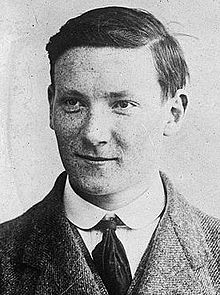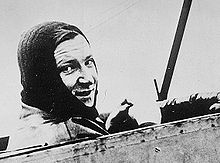Marcel Brindejonc des Moulinais - Picture
More Aviation History

|
|
Marcel Brindejonc des Moulinais

Picture - Marcel Brindejonc des Moulinais
Marcel-Georges Brindejonc des Moulinais (18 February 1892 - 18 August 1916) was a French aviator who died in World War I.
Biography
Brindejonc des Moulinais was born in Plérin in Cx´tes-d'Armor. He was the son of Jean-Georges Brindejonc des Moulinais and Blanche-Marie-Amélie Merlin. He was educated by the Institute of the Brothers of the Christian Schools, and then the college of Saint-Servan in Ille-et-Vilaine. From 1901 to 1912 he lived at "Le clos linden" in Pleurtuit at 41 rue Saint-Guillaume. His summer vacations were spent mostly with his cousins at Pleurtuit Val, near where his parents owned Pontouraude. As a student in 1910 he attended the University of Rennes.
His love of aviation arose during first flights at Dinan and Dinard during the summer of 1909, and especially during the summer of 1910. In 1910, he was diagnosed with appendicitis, which he suffered with until his death.

Picture - Marcel Brindejonc des Moulinais circa 1910
In December 1910, he bought an airplane from Alberto Santos-Dumont in Issy-les-Moulineaux. He then went to Pau where he enrolled in flight school. He obtained his civil pilot's license on March 23, 1911 (No. 448). In June, he participated in the meeting of Abbeville (Sum) on a Bleriot monoplane. After an interview with Gabriel Voisin in Issy-les-Moulineaux, he replaced soon by a first device Borel for a living and repay the loan he had made his family (4 000) , participating in exhibitions in Pau, Toulouse, Carcassonne, Perpignan, Foix. In July 1911, he returned to Paris: the company hired as the Morane pilot. At that time, he had a fall of fifty meters, the aircraft was attached to a crane by one of its stretchers, and was treated at the Boucicaut Hospital in Paris.
It quickly became an aviator renamed, participating in numerous events. The crowd watched with glee at the spectacle offered by Marcel Brindejonc mills Kercorb (Aude) on 15 February 1912. It was Juvisy-sur-Orge in April 1912. On 17 June 1912, the circuit of Anjou (accounting for the grand prize of the Aero-Club de France), where he had to complete seven times -Angers Cholet-saumur (1 100 km), despite the bad weather that nailed to the ground most pilots Avrillé, and despite opposition from the manufacturer of the aircraft (Léon Morane) it off. He ranks third on the Morane-Saulnier (equipped with a Gnome engine of 80 horsepower), having successfully reduced its gap with Roland Garros, which was the only one who can do the third and last lap. Marcel Brindejonc des Moulinais became famous throughout France, his name being associated with that of Roland Garros. On 8 August 1912, he tried unsuccessfully to win the Pommery cup on the route between Paris and Berlin. A mechanical incident in the Westphalia stopped him.
The year 1913 was the most glorious. His trip from Paris to London to Brussels to Paris (1 040 km on a monoplane Morane-Saulnier C, with double crossing of the Channel) took place from 25 to 27 February 1913. In London, he was sentenced to a fine of one thousand francs for suspended over the city. During his raid Paris-Bordeaux-Burgos-Madrid Barcelona to Perpignan Lyon Paris from 24 March to 12 April 1913, weather conditions were harsh: "What a terrible trip! How I suffer! One can not imagine!" He wrote.
The prestigious Pommery Cup trophy was given between 1909 and 1913, twice a year (before April 30 and before October 31), the aviator who traveled the greatest distance in one day (and then two days in 1913). Marcel Brindejonc des Moulinais made several unsuccessful attempts in 1912 and 1913: Paris-Berlin on 8 August 1912, Berlin-Villacoublay on 18 October 1912, attempted the impossible after the blessing of Morane-Saulnier at Villacoublay by the Bishop of Versailles (Game monsignor) on 22 October 1912, Paris-Mx¼nster on 29 April 1913, Bremen-Brussels-London from 9 to 11 May 1913. Despite cheating Guillaux of Mauritius, which claimed to have covered 1 386 km on 23 August 1913, Marcel Brindejonc Princesse de facto won the famous cup on 10 June 1913 on the 382.8 km 1 (length approved at a speed of 170 km At the judgments being counted) of Paris (Villacoublay, starting 3 h 37) in Warsaw (14 hours and arrived 18 minutes later). In Poland, he continued on his Morane-Saulnier H (two-seater monoplane, the pilot is in the rear-engined GNOME eighty horses) in a circuit of the capitals of Europe (a Just over 4 800 km) between June 10 and July 2, 1913: Warsaw-Dwinsk (June 15) - Saint Petersburg (June 17) Reval (June 23) - Stockholm (25 June) - Copenhagen (June 29) - The Hague (1 ((er)) July) Paris (Villacoublay, July 2). To cross the 300 km of the Baltic Sea, Marcel des Moulinais Brindejonc had obtained from the Russian navy, with the prince Liben, eight destroyers were placed on 25 June every eighteen miles between the island and Argo the Swedish capital. The reception was everywhere triumphant. The ovation was outstanding Villacoublay, where he arrived a little after four o'clock in the afternoon, escorted by at Villacoublay Corbeaulieu four monoplanes. He was received at City Hall from Paris. Newspapers around the world praised the courage of the young Breton. Quantity of letters of congratulation were simple address: "Brindejonc des Moulinais, France.
He was knighted in the order of Legion of Honor on 11 August 1913 he was twenty-one years, and he was the youngest of Legionnaire France. On 3 July 1913, he received the great gold medal of the Aero-Club de France. On 23 December 1913, he received the Medal of the Academy of Sport. He had been decorated at Saint Petersburg (by the Grand Duke Alexander) in the order of Sainte-Anne, Stockholm of the order of Gustav Vasa and Copenhagen ( June 30 by the king) in the order of Daneborg.

Picture - In the air.
On 20 July 1913, he won the match against Mauritius and Edmond Audemars Guillaux to Juvisy-sur-Orge, for the price of Essor, a test of speed climb organized by the newspaper L'Auto. On 12 August 1913, he traveled without incident thousand kilometers from Marseilles to Dinard, through Albi and Poitiers. (1)) (st September he flew to Dinard in Deauville and won Nantes Royan and Agen (845 km). From 27 to 29 September 1913, during the events of the Gordon Bennett Cup at Reims, he won the speed contest, and ranks second in the competition with high passenger.
Called to perform military service, it was incorporated on 10 October 1913 at 1 aerospace group to Versailles. On 10 April 1914 he was appointed Corporal, and assigned to the 2 ((e)) group of aviation Lyon.
He was allowed to participate in some civil trials. On 2 April 1914, he Vitoria-Madrid-Bordeaux-Marseille (1 083 km) in twelve hours and fifty-four seconds. On 3 April, he made Monaco-Marseille (210 km) in three hours and nine minutes. On 8 April he won the prize for best time on the Madrid-Monaco. On 20 April 1914, he participated in the test Monaco (Schneider Trophy), driving on a Morane-Saulnier, he had to abandon.
His advancement in the army was swift: Corporal Airman in the squadron DO 22 when war broke out in August 1914, Sergeant on 3 September 1914, second lieutenant on 25 December 1914, lieutenant December 26, 1915. He received the Croix de guerre on 2 June 1915.
On 4 August 1914, Corporal Marcel Brindejonc des Moulinais joined to Stenay (Meuse) DO Squadron 22, and flew on an aircraft Dorand. From August 11, he saw the advancing German armies left behind in the villages on fire. On the evening of 2 September he told the General Foch, who commanded the French army, which he had discovered on the march on Reims of the 3 German army (General von Hausen). His comments to the General Foch continued the following days he was flying with Captain Pujo.
On 9 September 1916, during the First Battle of the Marne, he reported three times that there was a hole between the German armies and Camp de Mailly. He had difficulty convincing. Intelligence was of the utmost importance. The clearance allowed the successful offensive against the French. On 13 September, General Joffre finally did issue a statement to the victory: "Our victory is increasingly complete. Everywhere the enemy is retreating."
Death
After the Battle of Champagne his health became increasingly poor and he was forced to rest in Britain. On 28 August 1915, he became the chief pilot at the flight school at Morane-Saulnier Bourget. On 30 May 1916 he joined a squadron as a pilot. Shortly after his return at dusk on 30 July 1916, both Maxime Lenoir and he shot down a Fokker. His plane was shot down on 18 August 1916 in Vadelaincourt near Verdun. He was buried in Souilly on 6 July 1922. Captain de Beauchamp, who would be killed on 10 November 1916, gave him tribute: "Brindejonc is the man in the plume, the symbol light, living, the beauty, honor passing very high, over life."
Further reading
Thierry Le Roy, Les Bretons and aerospace origins to 1939, PUR, Rennes, 2002.
Jean de Roumilly Gouin,a sublime Breton -Brindejonc des Moulinais, Imprimerie cornouaillaise, Quimper.
Illustrated Air War (which published the Diary of Marcel Brindejonc Moulinais).
Gilbert Broyelle, Brindejonc des Moulinais - Pioneer of Aviation 1892-1916, drawing Alain Goutal, album achieved through family archives and research by Suzanne Guidon, 1992.
More airplanes.
Source: WikiPedia